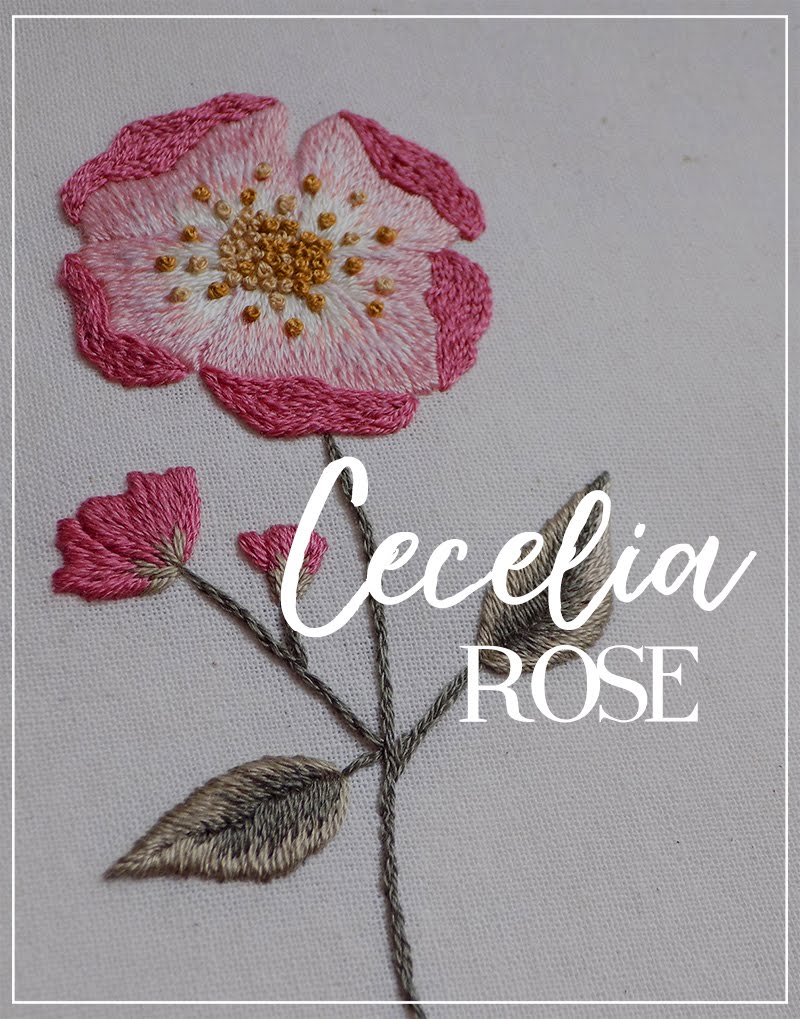Before we start with this tutorial, I recommend checking out this lesson:
Cast-on stitch and cast-on rose
Because the process of making the basic cast-on stitch is described in more details there and there is also a reference to a nice video tutorial if you struggle with understanding how to make the loops. You can also see a clearer process of making the loops in this Hydrangea video tutorial.
For the sake of comparison, I worked the “regular” cast-on stitch first.
The problem with this stitch is that since it hugs the needle quite closely, the final shape is narrow and thin, and will not always work for “fluffy” flowers. In the “Hydrangea” project I did cast-on stitches with only 1 strand of thread and made them tiny so that they look more dimensional.
However, if you want to use 2 strands of thread, for example, and want to make the flowers bigger without them being flat, you need to use the following trick.
1. We start in the same position. The needle first emerges at the starting point of the stitch, then you insert the needle where you want the stitch to end, and without pulling the thread through bring it up again at the starting point.
It is okay to bring the needle just very near to the starting point too, I actually do that to avoid picking up on the thread fibers.
For the “regular” cast-on stitch, that's where we would start casting the loops on the needle, but for the “fluffy” version...
2. We add an extra needle. Just insert it close to the working needle (personally, I haven't noticed any difference in the result no matter if the extra needle was added on the left or on the right. So just place it where it is more convenient for you).
3. And then we cast the stitches the very same way but on both of these needles at the same time. Be careful to not pull the thread too tight when forming the loops so that there is still some distance between the needles and they don't get mashed together.
4. One thing that I noticed from other, more experienced in this technique, stitchers and had added to my process as well, is casting the thread under the needle as the finishing touch. To this day, I can't put in words the reason why it has an effect, but it does for me. It makes that end of the stitch a little tighter, and the “danger” of having loose loops decreased.
5. So here we have the resulting cast-on stitch and you can see that it is at least double “taller” than the original one.
The “fluffiness” extent will depend on the size of the loops, so to make it even more dimensional, you can increase the distance between the needles, or use any other extra materials.
Here, for example, I used a cut tip of a gel pen ink chamber and put it right on top of the needle.
Here's how fluffy it made the cast-on stitch.
Remember:
All the essential tips for making the regular cast-on stitch stay the same for its fluffy version.
- Don't pull the thread too hard;
- Try to cast the loops evenly on the needle;
- Always hold the loops with your thumb when pulling the needle through at the end;
- I didn't have a dull point needle at hand, but it would be better to use one as an extra.
***
Let's practice this skill and make a little flower!
First, prepare the center of a flower by making some french knots (or you can use any other technique).
Then we will start making cast-on stitches connecting the following points:
A-C
B-D
C-E
E-B (the stitch will end at the front of the the first one, not behind it).
And so we go on until we have the flower complete.
Hope it helps you in making some pretty flowers for your next project! Take care! :)






























Hi Amina!!! simplemente, exquisito! Gracias por compartir tus conocimientos. Cariños desde Cordoba, Argentina.
ReplyDeleteGracias, Fabiana! :)
DeleteHi Amina!!! simplemente, exquisito! Gracias por compartir tus conocimientos. Cariños desde Cordoba, Argentina.
ReplyDeleteLove it! The big cast-on stitches would work great for the curls on a girl's embroidered hair. Thank you for the tutorial.
ReplyDeleteTotally! that's a fun way to use it :)
DeleteHuge thank you for this tutorial! Cast-on stitches seemed for me very tricky, but your explanation helped me a lot!
ReplyDeleteThank you for reading :)
DeleteThis is amazing! I'm so glad I found your website. Thanks for sharing this tutorial.
ReplyDelete